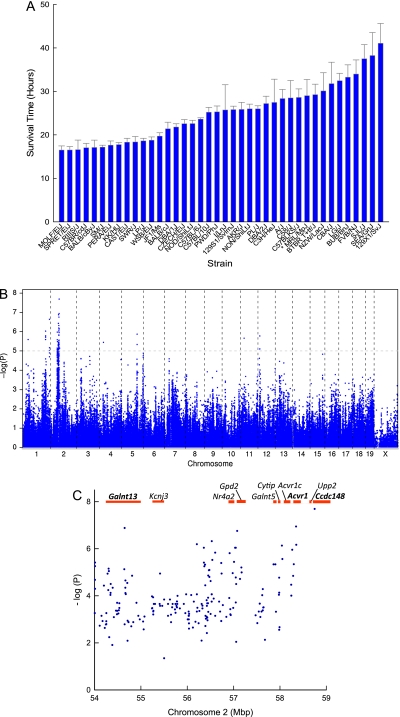Figure 1.
Mouse strains vary in sensitivity to acrolein-induced acute lung injury. (A) Acute lung injury survival time of 40 mouse strains. Mice were exposed to 10 ppm acrolein for up to 24 hours and survival time recorded hourly. Values are mean ± SE (n = 6 to 16 mice/strain except MRL/MpJ, n = 3). (B) Haplotype association map for acrolein-induced acute lung injury in mice. The scatter (Manhattan) plot of corresponding −log(P) association probability for single nucleotide polymorphism (SNP) at indicated chromosomal location (ordinate). Transcripts with SNP associations of −log(P) > 4.0 were selected for further analysis. (C) Candidate genes on mouse chromosome 2 associated with acrolein-induced acute lung injury. The Manhattan plot of SNP associations indicates chromosomal location (ordinate) and corresponding –log(P) association probability. Genes with one or more significant SNP (−log[P] > 6.0) included Galnt13 (UDP-N-acetyl-α-D-galactosamine:polypeptide N-acetylgalacto-aminyl transferase 13), Acvr1 (activin A receptor, type 1), and Ccdc148 (coiled-coil domain containing 148). Acvr1c = activin A receptor, type IC; Cytip = cytohesin 1 interacting protein; Galnt5 = UDP-N-acetyl-α-D-galactosamine:polypeptide N-acetyl-galactosaminyl transferase 5; Gpd2 = glycerol phosphate dehydrogenase 2, mitochondrial; Kcnj3 = potassium inwardly-rectifying channel, subfamily J, member 3; Nr4a2 = nuclear receptor subfamily 4, group A, member 2.

